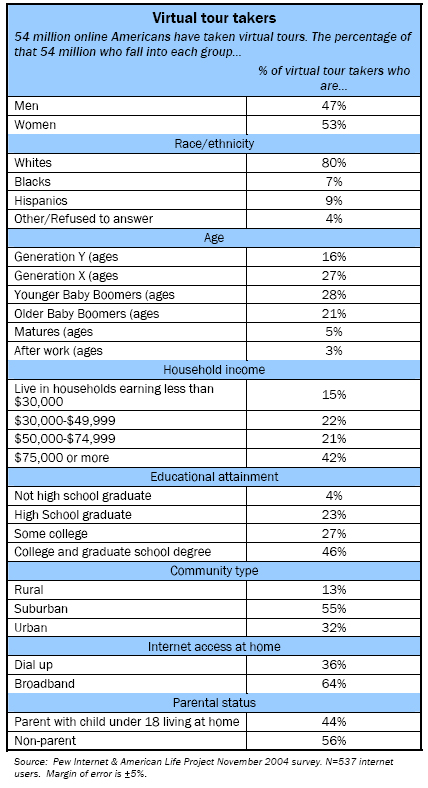54 million Americans have used the internet to take virtual tours
Since the dawn of the Web in the early 1990s, internet advocates have argued that one of the Web’s most powerful applications would be to open up new worlds to people and help them easily experience faraway places.
A new survey by the Pew Internet & American Life Project finds that 45% of online American adults have taken advantage of this internet application and taken virtual tours of another location online. That represents 54 million adults who have used the internet to venture somewhere else.
On a typical day, more than two million people are using the internet to take a virtual tour.
Some of the most popular virtual tour destinations include museums, tourist and vacation locales, colleges and prep schools, real estate, historical exhibits, parks and nature preserves, public places such as the White House and the Taj Mahal, and hotels and motels.
This is a first-time measurement by the Project that came in its most recent tracking survey between November 23 and November 30. It is not possible for us to say how fast this activity online has been growing, but it is safe to say that the spread of broadband connections has made virtual tours easier and encouraged those who create tours to create richer tour experiences through streamed tours. Some 65% of those who have broadband connections at home and 63% of those who have broadband connections at work have taken virtual tours.
Unlike many other internet activities, virtual tours are not the province of young internet users. Indeed, 51% of younger Baby Boomers (those age 40-49) have taken virtual tours, compared to just 37% of those in Generation Y (ages 18-27). Those who take virtual tours are also highly educated: 58% of the internet users with college or graduate degrees have taken virtual tours. In addition, tour takers are slightly more likely to be urban than rural (51% of urban internet users have taken virtual tours vs. 42% of online rural residents).

The nationwide phone survey cited here involved interviews with 914 adults, 534 of whom are internet users. The margin of error is plus or minus four percentage points.
The Pew Internet & American Life Project is a non-profit initiative of the Pew Research Center and is funded by the Pew Charitable Trusts to examine the social impact of the internet. The Project does not advocate any policy outcomes. It is non-partisan.


